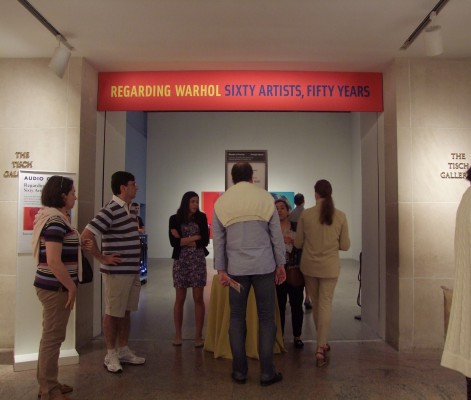Policies on Photography in Museums: Too Restrictive?
November 21, 2013

Since the incredible development of cameras, we’ve all become “photographers”: from your grandmother who proudly shows you the pictures she took with her iPhone to your little cousins with their iPads. There is the ever-growing tendency to take pictures every step of the day: from breakfast in a ‘50s-themed diner in the Village, to an afternoon walk by the windows of a store on Fifth Avenue. Astonishingly, the place where these new, and old, photographers are stopped from sharing their everyday experiences is in cultural centers, especially in museums. Deborah Solomon, columnist for the New York Times (NYT) and art critic for WNYC radio, analyzed this issue in a recent op-ed for the NYT, stressing that, taking (non-flash) photographs of works of art is beneficial to the audience for the most part.
The policies about photography in museums change from institution to institution. In museums that would allow photography in their regular exhibitions, you would be stopped by a uniformed guard yelling: “No photos!” if you tried to get a shot of a special exhibition. Even more strict art institutions, such as The Frick Collection on the Upper East Side, don’t allow photography in general and also don’t allow children under 10 years old. What happened to the museum’s traditional mission of educating the young to appreciate art? Worst case scenario: you’ll have to tell your little cousins that they can’t come in with you —and neither can their best friend, their iPads.
Solomon said, this policy is “obsolete,” in her September column for the NYT “Hey ‘Starry Night,’ Say ‘Cheese!’” Solomon makes good points in the defense of photographers but also considers the concerns of institutions for having too many photographers “blocking the traffic” in museums and stopping in front of a work of art just to take a picture of it without even stopping to analyze and really appreciate it. In the defense of museum–goers instead, Solomon states that taking pictures of works of art really helps the audience analyze the art piece because they can frame it and analyze its lines and technique. “When you gaze through a lens, you are likely to consider the world more deeply. You frame space and take note of composition, the curve of a line, the play of light and shadow.”
Being a journalist, an art history minor and a photography-lover, I can relate to this article. There have been countless times when I have had to sneakily take a picture of a work of art simply because I liked it or because I needed it for an art history assignment or even for an Observer article. The affectionate part of it plays its role too. If I can’t photograph something, I would forget to look the catalog picture up on the Internet, or if I do, it wouldn’t give me the same effect as a picture that I took myself.
In the column, Solomon also makes the claim of how we can use our beloved social media accounts to share opinions on a work of art. Even though I use social media occasionally, I do look at other art-lovers’ Instagrams and social media accounts in order to find out about other new exhibitions I would like to see. Solomon defends the use of social media in this sense as well, empathizing its educational use. “When we photograph, e-mail, tweet and Instagram paintings, we capitalize on technological innovation to expand familiarity with an ancient form. So, we too increase the visual literacy of this country. Much can be gained. Nothing can be lost. A photograph of a painting can no more destroy a masterpiece than it can create one.”
As Solomon mentions, many institutions today are working on reviewing their policies on taking pictures, but none of these have made changes yet, as reported by The Frick director, Ian Wardropper. For now, we will need to keep on hiding our cameras and phones under our coats.









